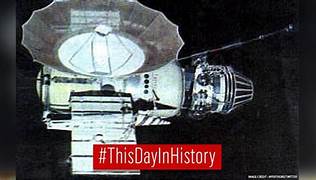On October18 1967, the Soviet Union achieved a significant milestone in space exploration with the successful launch of the Venera 4 spacecraft towards the planet Venus. Venera 4 became the first spacecraft in history to penetrate the atmosphere of another planet, providing valuable insights into the composition and conditions of Venus. The Venera program, initiated by the Soviet Union in the early 1960s, aimed to explore Venus, often referred to as Earth's "sister planet," due to its similar size and proximity to our planet. Prior missions had focused on capturing images and collecting data from Venus's surface, but the Venera 4 mission sought to delve deeper into the planet's atmosphere. Venera 4 was launched on June 12, 1967, aboard a Molniya rocket. After a journey of over four months, it entered the atmosphere of Venus on October 18, 1967. The spacecraft was equipped with scientific instruments to measure temperature, pressure, and composition as it descended through the planet's thick atmosphere. During the descent, Venera 4 faced extreme conditions, including high temperatures, pressures, and corrosive gases. Despite these challenges, the spacecraft successfully transmitted data back to Earth for approximately 93 minutes before its demise. The data received from Venera 4 provided groundbreaking insights into the atmosphere of Venus. It revealed that Venus's atmosphere was primarily composed of carbon dioxide, with traces of nitrogen and other gases. The temperature and pressure measurements indicated an inhospitable environment, with surface temperatures exceeding 450 degrees Celsius (842 degrees Fahrenheit) and pressures about 75 times greater than Earth's atmosphere. The successful mission of Venera 4 marked a significant achievement in space exploration. It demonstrated the technological capabilities of the Soviet Union and their ability to conduct complex missions in the harsh environment of another planet. The mission also expanded our understanding of Venus and provided valuable data for future missions and scientific research. The Venera program continued with subsequent missions, each building upon the knowledge gained from previous endeavors. The later Venera missions, such as Venera 9 and Venera 10 in 1975, successfully landed on the surface of Venus and transmitted the first images from its rugged terrain. The exploration of Venus by the Venera program paved the way for future missions to the planet, including those conducted by other space agencies. The data collected by Venera 4 and subsequent missions contributed to our understanding of the planetary atmosphere, climate, and geology of Venus. Despite the challenges and limited lifespan of the spacecraft, Venera 4 achieved a significant milestone in space exploration by penetrating the atmosphere of another planet for the first time. It expanded our knowledge of Venus and set the stage for further exploration and scientific discoveries. The legacy of Venera 4 and the Venera program as a whole continues to inspire future missions to Venus and other celestial bodies. The data and lessons learned from these missions have contributed to our broader understanding of the solar system and the possibilities for life beyond Earth.
18 Oct, 1967 Space Venus 4
